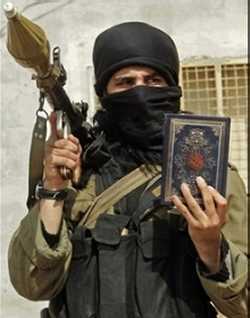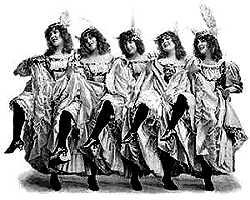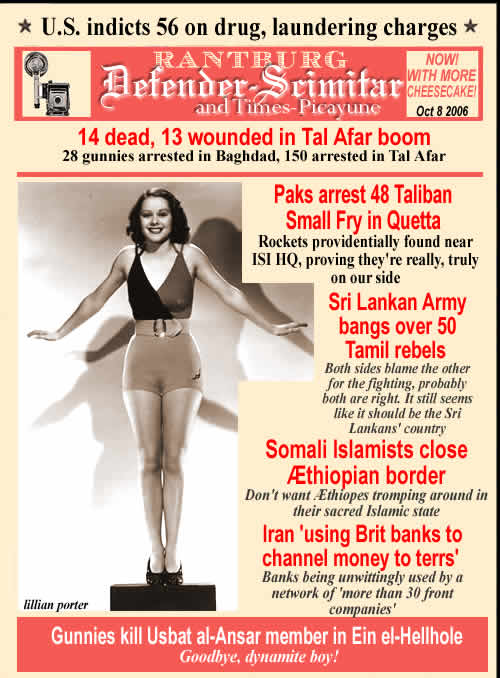 Ein El-Hilweh Refugee Camp, Lebanon - For three months, Abeer Qandaqli and her sister-in-law, Farida al-Shaabi, moved from house to house amid the rubble of a besieged Palestinian refugee camp, surviving on canned food, as their husbands - both Islamic militants - waged a battle against the Lebanese army. Ein El-Hilweh Refugee Camp, Lebanon - For three months, Abeer Qandaqli and her sister-in-law, Farida al-Shaabi, moved from house to house amid the rubble of a besieged Palestinian refugee camp, surviving on canned food, as their husbands - both Islamic militants - waged a battle against the Lebanese army.
| To what end, other than the detriment of their families and to prove their own mortality? |
The two women, both in their late 20s, were among 25 wives of Fatah Islam fighters evacuated with their 38 children from the besieged Nahr el-Bared camp a week ago. Now, the two women are living in this southern Lebanese Palestinian refugee camp,
| ... no haven of normality itself... |
where their stories, recounted by their families, shed a bit of light on the confusion surrounding the militant group since the siege began. The two women did not talk to reporters themselves.
One of the women, Al-Shaabi, is the Palestinian wife of Shehab al-Qaddour, better known as Fatah Islam's deputy leader Abu Hureira, who was nailed killed earlier this month. It's not clear if Mohammed al-Shaabi, Qandaqli's husband and Farida al-Shaabi's brother, is still alive.
| I, personally, hope neither is dead, but both have been hideously disfigured, crippled to the point where they can't change their own colostomy bags. |
Qandaqli's mother, Amal Sweidi, said her daughter left her home at Ein el-Hilweh camp for the bright lights of Nahr el-Bared two months before the fighting erupted there on May 20. She had no idea her husband was a fighter with the al-Qaida-inspired Fatah al-Islam, but she would have gone even if she had known, Sweidi said. "Wouldn't you follow your husband wherever he goes?" asked Sweidi, 51.
| Now that you bring it up, if my wife bought a boom belt, I'd settle for a new shirt and a bus ticket. |
During a brief truce three days after the war began, designed to allow civilians flee, Qandaqli sent her two sons, ages 8 and 10, out of the camp. Farida al-Shaabi also sent four of her children out, but kept her 10-month-old son with her, said her sister, Fadia al-Shaabi, speaking at her home here. Two weeks after the fighting started, the two women were separated from their husbands and have not seen them since, their families said.
| "I'm so distraught! Who will massage my darling's stumps?" |
The fighting between Fatah al-Islam and the Lebanese army at Nahr el-Bared has killed about 148 soldiers and an unknown number of militants, who have vowed to fight until their deaths.
| Sounds good. They should stick to that objective. |
About a dozen of the other Fatah al-Islam wives who were evacuated last week, and have other various Arab nationalities, are staying at a mosque in Sidon, near Ein el-Hilweh, guarded by Lebanese security dressed in civilian clothes.
| Describing them as "in mufti" sounds kinda redundant, since the broads are holed up in a mosque. |
The rest of the evacuated women and children are in Beddawi, another northern Palestinian refugee camp near Nahr el-Bared. All have been interrogated by Lebanese security, but security officials said the women have refused to talk.
| "I ain't sayin' nuttin' widdout me mout'piece, coppers! Nuttin'!" |
"They're not saying a word, except that they were in one bomb shelter and their husbands in others," said one official. "They will probably stay in Lebanon until the military operation is over, or until we can deport them to their respective countries."
| I'd just go ahead and deport them. They'll just marry other religious nitwitz. |
Some in Palestinian camps are unhappy with the presence of the newly evacuated Fatah al-Islam wives. "We prefer they stay away from our camp," said Raed Shbaitah, a senior official of the mainstream Palestinian Fatah movement in the Ein el-Hilweh camp, referring to the families. "We have enough problems of our own."
| Raed sounds like he's got a head on his shoulders. Of course, if the Islamists were to take over he probably wouldn't. |
Abu Hureira, the deputy militant leader, who is Lebanese, was on the run from Lebanese law when he fled to Ein el-Hilweh more than 10 years ago and later married al-Shaabi. The camp, the largest of the 12 Palestinian refugee camps in Lebanon, has become a haven for extremists and criminals because of its lawlessness. Under a 1969 Arab League agreement, the camps are off-limits to Lebanese security.
| And the Paleostinians certainly aren't big on concepts like "law" and "order." They're Zionist plots. |
Abu Hureira started out roaming the camp's streets selling Arabic coffee or bread on a mobile cart. In 2000, he joined Usbat al-Ansar, an extremist Palestinian group based at Ein el-Hilweh and believed to have strong links with Fatah al-Islam. He left for Nahr el-Bared with his brother-in-law and their families a few months before the fighting started there.
"We're goin' to Nahr al-Bared, there to make our fortunes!"
"G'bye! Don't come back!" |
Mohammed al-Shaabi had worked in a co-op, distributing food, shampoo and detergent to Ein el-Hilweh's grocery stores when he met his wife, Qandaqli. About three years ago, he also joined Asbat al-Ansar.
| Maybe it was her perfume? After only three months he really shoulda been interested in other things. |
Many of the Fatah Islam guerrillas fighting in Nahr el-Bared had previously been with Usbat al-Ansar - an indication the two may be basically the same, merely operating under different names, or share similar ideologies and goals.
| Whoa! Picked right up on that, didn't you? When I was a child we got tired of eating hot dogs, so Mom decided to feed us tube steaks. When we got tired that, we got franks. And when that wore off, we got wieners. |
Al-Shaabi's mother-in-law, Sweidi, insisted he was not affiliated with Fatah al-Islam when he first left Ein el-Hilweh. "Nobody had heard of Fatah al-Islam," she said. And Sweidi said she and her daughter were not happy when her son-in-law joined Usbat al-Ansar. She called her son-in-law a "good man" but blamed Fatah Islam for her daughter's suffering. Both Qandaqli and Farida al-Shaabi lost so much weight while stuck in Nahr el-Bared that they need medical treatment, she said. "May God's curse fall on those who caused all the suffering," said Sweidi, referring to Fatah al-Islam. |
 [An Nahar] A hand grenade went
[An Nahar] A hand grenade went 
 [ENGLISH.ALARABIYA.NET] The government of the United Arab Emirates formally endorsed on Saturday the designation of 82 organizations, including Egyptâs Muslim Brotherhood and the Islamic State of Iraq and Syria (ISIS), as terror groups, in line with a federal law on combating terrorism.
[ENGLISH.ALARABIYA.NET] The government of the United Arab Emirates formally endorsed on Saturday the designation of 82 organizations, including Egyptâs Muslim Brotherhood and the Islamic State of Iraq and Syria (ISIS), as terror groups, in line with a federal law on combating terrorism. Two people were killed on Saturday in clashes between members of the Fatah faction and Sunni Islamist militants at a Palestinian refugee camp in south Lebanon, camp officials said.
Two people were killed on Saturday in clashes between members of the Fatah faction and Sunni Islamist militants at a Palestinian refugee camp in south Lebanon, camp officials said.  The first military examining magistrate
The first military examining magistrate  Ein El-Hilweh Refugee Camp, Lebanon - For three months, Abeer Qandaqli and her sister-in-law, Farida al-Shaabi, moved from house to house amid the rubble of a besieged Palestinian refugee camp, surviving on canned food, as their husbands - both Islamic militants - waged a battle against the Lebanese army.
Ein El-Hilweh Refugee Camp, Lebanon - For three months, Abeer Qandaqli and her sister-in-law, Farida al-Shaabi, moved from house to house amid the rubble of a besieged Palestinian refugee camp, surviving on canned food, as their husbands - both Islamic militants - waged a battle against the Lebanese army. NAHR AL BARED, Lebanon: Lebanese troops advanced for the first time yesterday into a Palestinian refugee camp as they battled Al Qaeda-inspired militants, and two soldiers were killed raising the military death toll to 100.
NAHR AL BARED, Lebanon: Lebanese troops advanced for the first time yesterday into a Palestinian refugee camp as they battled Al Qaeda-inspired militants, and two soldiers were killed raising the military death toll to 100.  Lebanese troops fought close-quarter battles with al Qaeda-inspired militants at a Palestinian refugee camp in north Lebanon on Sunday while an Islamist activist was gunned down in the south.
Lebanese troops fought close-quarter battles with al Qaeda-inspired militants at a Palestinian refugee camp in north Lebanon on Sunday while an Islamist activist was gunned down in the south.  As Ya Libnan has reported earlier clashes broke out between the mainstream Fatah organization and Jund al-Sham extremists in the southern refugee camp of Ein el-Hilweh according to reliable sources. The fighting later escalated to include the Lebanese army when Jund al-Sham militants threw a grenade at the army post which resulted in injuring a civilian and a Lebanese army soldier. New reports say Usbat-al-Ansar has joined Jund al-Sham in their fight against the army and are also firing at the civilians in the camp. The report added: " fighting continues at camp of Ein el-Hilweh and that the Lebanese army has received reinforcement."
As Ya Libnan has reported earlier clashes broke out between the mainstream Fatah organization and Jund al-Sham extremists in the southern refugee camp of Ein el-Hilweh according to reliable sources. The fighting later escalated to include the Lebanese army when Jund al-Sham militants threw a grenade at the army post which resulted in injuring a civilian and a Lebanese army soldier. New reports say Usbat-al-Ansar has joined Jund al-Sham in their fight against the army and are also firing at the civilians in the camp. The report added: " fighting continues at camp of Ein el-Hilweh and that the Lebanese army has received reinforcement."